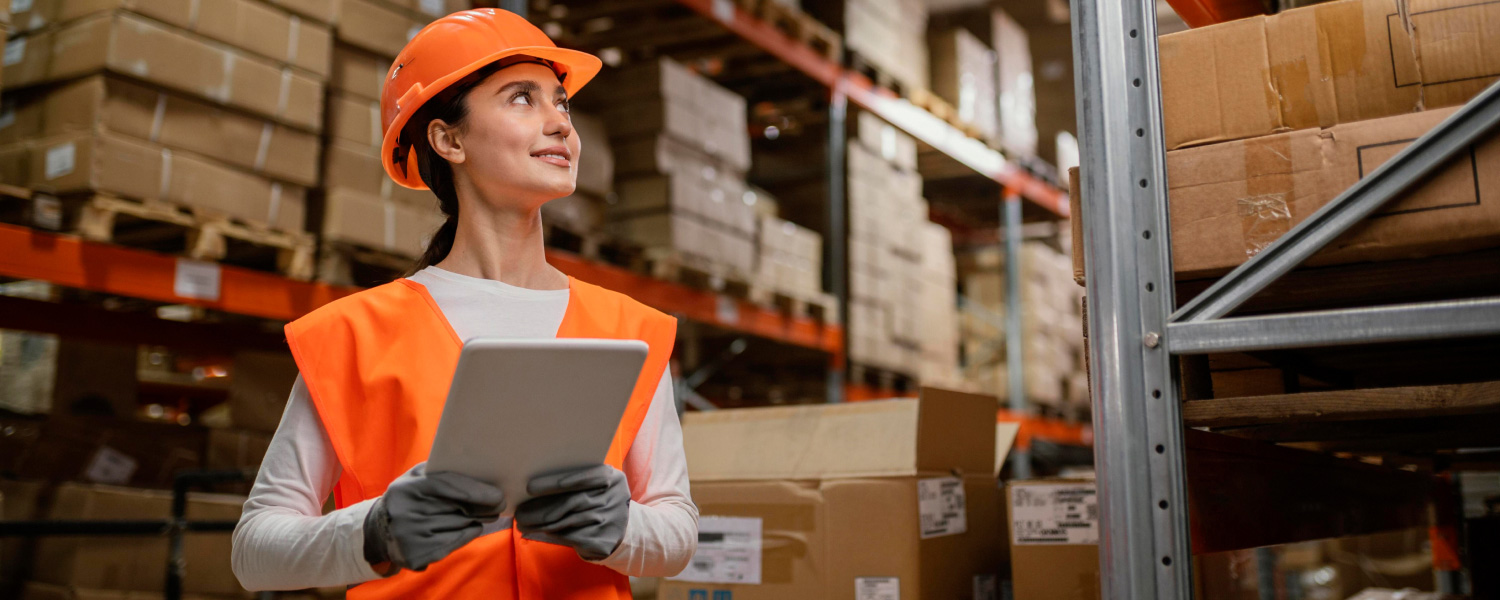Are you curious about how AI is transforming warehouse operations?
According to McKinsey’s latest State of AI report, over half of all businesses, a striking 56%, have already implemented AI in at least one area.
This adoption rate is even higher in emerging markets such as China, the Middle East, and North Africa, reaching 57%.
As this trend continues to accelerate, AI is becoming a game-changer for warehousing, offering major improvements in efficiency, accuracy, and cost savings.
In this blog, we will share the top five benefits of AI warehouse automation that are driving these advancements.
Find out how AI warehouse automation can simplify your warehouse operations and help you stay competitive.
The Evolution of Artificial Intelligence in Warehouse Automation
Have you ever wondered how artificial intelligence (AI) made its way into warehouse automation?
The journey of artificial intelligence in warehouse automation began with the growing need for efficiency and accuracy in managing complex logistics and supply chains.
This created a perfect opportunity for AI technologies to step into the warehousing industry.
The journey of artificial intelligence in warehouse automation can be traced through the following timeline:
Early 2000s: The Need for Efficiency
As e-commerce began to boom, the demand for faster and more accurate warehouse operations increased.
Traditional methods struggled to keep pace with the surge in online shopping, creating an opportunity for AI warehouse automation to step in.
Mid-2000s: Introduction of Machine Learning and Stocked Robotics
AI started to make its way with machine learning algorithms being used to optimize routing and scheduling.
The introduction of stocked robotics equipped with AI further enhanced warehouse operations by automating repetitive tasks like picking, packing, and sorting, reducing human error and speeding up processes.
Late 2010s to Present: Mainstream Adoption and Advanced Applications
In recent years, AI technologies such as computer vision and natural language processing have advanced significantly.
Companies like Amazon and Alibaba have set new standards by integrating AI into complex tasks like inventory management and predictive maintenance.
Today, AI warehouse automation is mainstream, driving continuous improvements in the warehousing industry.
5 Surprising Benefits of AI Warehouse Automation

Struggling with warehouse operations? AI might be the game-changer you need.
AI is here to transform warehouse management, making processes faster, more efficient, and highly accurate.
Let’s talk about the five amazing benefits of AI warehouse automation.
From reducing errors to saving costs, these advancements are transforming warehouses into high-tech hubs of productivity.
1. Smart Demand Prediction and AI Inventory Management
Are you tired of disappointing customers with out-of-stock items? In the past year, 65% of online shoppers have faced this frustration.
You don’t have to fear losing customers anymore! With AI, you can accurately predict demand and optimize inventory.
By analyzing past data, market trends, and other factors, AI algorithms provide accurate forecasts.
AI inventory management enables warehouses to improve their operations in the following ways:
- Enhances Supply Chain Processes: Using AI for inventory management improves overall supply chain efficiency.
- Anticipates Demand Changes: It predicts shifts in demand accurately.
- Optimizes Decision-Making: Brands that use AI for inventory management make informed choices about buying, shipping, and managing inventory.
With AI inventory management, businesses can ensure they have the right products at the right time, reducing costs and enhancing efficiency.
Want to see how automated inventory management can simplify your warehouse operations? Schedule a demo for Teamship’s WMS today and witness it yourself.
2. Maximized Space Utilization
One common challenge faced by warehouse managers is constantly running out of storage space.
AI plays an important role in maximizing space utilization in warehouses.
Here’s how:
- Optimized Layout Planning: AI analyzes warehouse layouts to design the most efficient storage configurations, ensuring every inch of space is used effectively.
- Dynamic Storage Allocation: AI algorithms determine the best locations for items based on factors like size, weight, and frequency of access, reducing wasted space.
- Real-Time Space Monitoring: AI continuously monitors space usage, identifying areas of improvement and suggesting adjustments to optimize storage.
- Efficient Slotting Strategies: AI helps develop efficient slotting strategies by placing high-demand items in easily accessible locations, reducing retrieval times and improving overall efficiency.
By using AI, warehouses can make the most of their available space, leading to increased storage capacity and better operational efficiency.
3. Improved Worker’s Safety
Every year, nearly 20,000 workers suffer injuries from forklift accidents alone.
AI-driven robotics and automation are changing the game for warehouse operations by making them safer for employees.
Technologies like autonomous mobile robots (AMRs) and robotic piece picking solutions are making warehouses safer for workers.
These smart systems can move through aisles, find specific items, and quickly handle tasks like picking, sorting, and packing.
Adding AI-powered robots to warehouse workflows can significantly improve the safety of your warehouse employees.
Robotics integration leads to better labor utilization, a smoother supply chain, and a fast return on investment.
4. Reduced Errors with Automated Warehouse Picking
With automated warehouse picking, AI systems ensure that items are selected accurately, minimizing human errors that often occur during manual picking.
These AI-driven solutions can analyze data, recognize patterns, and optimize picking routes, making the process more efficient and reliable.
Automated warehouse picking systems use advanced sensors and machine learning algorithms to verify the correct items and quantities are picked. This leads to fewer mistakes, reducing the need for returns and reprocessing.
By incorporating AI into warehouse operations, businesses can achieve higher accuracy and improved customer satisfaction.
Check out Teamship’s smart pick and pack options for brands and minimize errors with our dual scan process.
5. Enhanced Equipment Maintenance
By analyzing real-time data from sensors and monitoring systems, AI can forecast equipment failures and maintenance needs accurately.
Implementing predictive maintenance strategies helps warehouse operators reduce downtime, lower maintenance costs, and keep essential machinery and infrastructure running smoothly.
Consequently, operators can proactively schedule maintenance, ensuring optimal performance and longevity of equipment.
Automate your Warehouse with Teamship
Imagine a system where tedious tasks like picking, packing, and sorting are handled efficiently by an advanced warehouse management system.
With Teamship, you can automate and streamline your entire warehouse management process, making it more efficient and less prone to errors.
Here’s how Teamship can automate your warehouse operations for you:
1. Unify Inventory Management
Teamship allows you to manage all your inventory from a unified platform.
This means you can track stock levels, monitor movements, and manage orders seamlessly across multiple locations.
No more juggling different systems or spreadsheets, everything you need is in one place, making your job easier and more efficient.
2. Centralize Warehouses
With Teamship, you can centralize your warehouse operations to get a holistic overview of all your warehouses with a single login.
This centralization helps in better coordination and resource allocation for more efficient operations.
You can oversee activities, streamline processes, and ensure that all your warehouses operate in harmony.
3. Simplify Warehouse Agreements
Teamship simplifies the management of warehouse agreements by automating and centralizing the documentation process.
You can easily create, track, and manage agreements with various stakeholders, ensuring compliance and reducing administrative burden.
Now you can focus on more critical tasks and improve overall productivity.
Say goodbye to stockouts and overstocking issues. With Teamship, you’ll always have the right products at the right time.
Reach out to us today to see how our warehouse automation solutions can simplify your warehouse operations.
Final Thoughts
AI is taking over the world, and its impact on warehouse management is undeniable.
According to a report by Gartner, 50% of large global companies started using AI, advanced analytics, and IoT in supply chain operations in 2023.
The benefits of implementing an artificial intelligence warehouse are vast, from reducing errors to ensuring employee safety and improving overall efficiency.
Adopting an artificial intelligence warehouse has become essential for staying competitive in the industry.
It’s the perfect time to adopt AI and transform your warehouse operations to keep up with the future of logistics.
Frequently Asked Questions
1. What is the market size for warehouse automation?
The global warehouse automation market was valued at USD 16.23 billion in 2022.
It is projected to reach approximately USD 71.03 billion by 2032, growing at a compound annual growth rate (CAGR) of 15.91% from 2023 to 2032.
2. Should I go for warehouse AI automation?
Absolutely, adopting warehouse AI automation can significantly enhance your operations.
With warehouse AI, you can improve efficiency, reduce errors, and optimize inventory management.
As the industry evolves, transforming your current warehouse to an AI warehouse will keep you competitive and ensure centralization of operations.
3. How many warehouses use automation?
Currently, over 80% of warehouses have not adopted any form of automation.
In contrast, only about 5% have implemented advanced automation technologies and solutions in the past decade (BusinessWire, 2021).
However, warehouse automation is a trend that is increasingly gaining traction.

